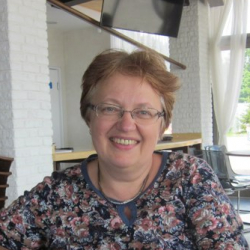
Speaking Tips
Ефимова Е.Д.
Учитель английского языка
ГБОУ СОШ № 69

SOME RULES
1. Don’t be afraid of making mistakes. Anyone who speaks can make a mistake.
2. Speak with your partner naturally.
3 . Pay attention to the explanation of the situation carefully.
4. Remember the situation is not about yourself
but you have to think as someone else.
5. Try and interact with your partner.
5. Ask your partner’s suggestions, opinions.
6. If you speak in a group, change roles.
etc…

& not only games

RECORDING
1. Give a speaking task as a home entertainment.
2. Let Ss record themselves doing the task with the
help of their mobile phones, sites ( www.vocaroo.com ; etc.)
3. Let them share their audios in class. (Personal exchange is also
possible depending on a group or a goal)
4. Have a feedback session.

DESCRIBING THINGS Ss DON’T KNOW
- Show a thing (or its picture) Ss don’t know the name in English,
but they could guess or create themselves (e.g. coffee maker)
2. Explain its functions in general : “It’s something
you use for making coffee.”
3. Let Ss guess what it could be and ask questions to the teacher.
(pair or group work)
4. Show Ss pictures and let them practice in describing using
“ We thought…”, “In our opinion it was…, but….” etc.

GUESS WHAT (SKETCH & GUESS)
to practise describing pictures in groups.
1. Divide Ss into groups.
2. Give a picture (it could be funny) to one of the Ss.
3. Let the student describe it to students who attempt to draw the picture
together. The student whose picture closely resembles the original will win.
4. Let the Ss discuss the Name of the character or the object given
and describe it and its functions (practicing SWO and CAN/CAN’T, etc.)

GUESS WHAT (SKETCH & GUESS)
to practise describing pictures personally.
1. Give a picture to one student. Using funny pictures makes this more fun.
2. Let the student describe it to a class in detail .
3. Ss try to draw it.
4. The student whose picture closely resembles the original will win .

THE COMMON ASPECT
1. Give out many pictures that relate to the same topic.
2. Let the Ss find what connects them (e.g., they all can see people eating).
3. A group discussion which leads to a list of useful vocabulary and grammar.
4. After a group discussion of what aspects of (eating) they can see,
they choose one to describe in one minute . Each S describes one aspect.

ACTIVE PICTURES
1. Divide the class into two groups.
2. Give a picture to one group. Give time to discuss their acting.
3. The group with the picture acts out in silence.
4. The other group has to understand who/what is in the picture, what is happening in the picture, etc.

PHOTO DESCRIPTION
1. Place (Show) 4 photos on the IWB (TV screen, BB, etc.)
2. Give one of the pictures (in paper) to a student. The others don’t know which one.
3. Two tasks are possible : A) the group asks the students questions to guess which picture he/she has; or B) the students must say some sentences about the picture.
4. The goal is to make the group/student guess the picture
correctly.

FOLLOWING INSTRUCTIONS
1. Print out a poster size version of the speaking test and place it on a magnetic board.
2. Cut out some images from flashcards or magazines and laminate them.
3. Think of how to stick images on the poster. Everything depends on what you have at your disposal.
4. Practise with the Ss by giving instructions to place items on different places.

INTERACTION
1. Prepare cards with questions or different ideas.
2 . Give Ss those cards and instructions
how to find a partner for chatting.
3. They have to put together as many different questions as they can and then, after checking them……
4. They can practise their speaking in pairs.

Контакты:
ЕФИМОВА Елена Дмитриевна
[email protected]
(8-921-960-2886)
https://vk.com/e.elena64
https://vk.com/club33019391
С п а с и б о за внимание!






























